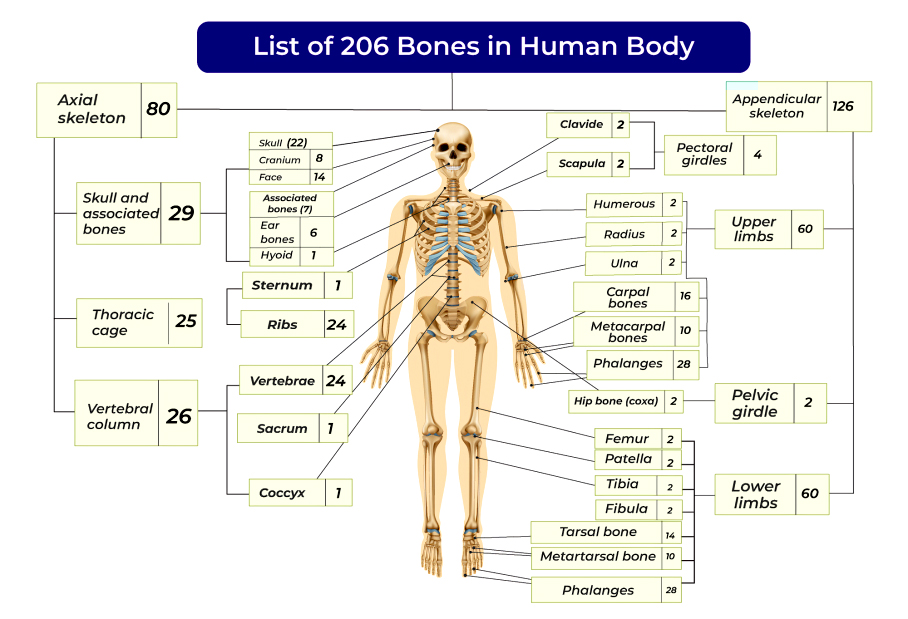
Bones in Human Body: Human bones are composed of connective tissue strengthened with calcium and specialised bone cells, including osteoblasts, osteocytes, and osteoclasts. Each bone within the human skeleton consists of layers, each housing a distinct type of bone tissue: the periosteum, compact tissue, cartilaginous tissue, and bone marrow. The body continually adjusts the skeleton by depositing new bone tissue when necessary and resorbing old tissue when no longer required. Maintaining healthy bones necessitates a well-balanced diet, regular weight-bearing exercise, and appropriate hormone levels.
The skeletal, muscular, and articular systems collaborate to provide structural support to the body and facilitate movement. Furthermore, they shield vital organs such as the brain, heart, and lungs while contributing to body contour. This integrated system is commonly referred to as the musculoskeletal system. NEET Biology Notes on bones in human body including types and functions of bones in the human body.Bones in Human Body
The human skeleton consists of 206 bones, excluding sesamoid bones and teeth. These bones are divided into two categories: axial and appendicular. The axial skeleton contains 80 bones, including the skull, hyoid, ribs, trunk, and sternum, which provide central structural support. The appendicular skeleton, on the other hand, consists of 126 bones that make up the limbs and their associated girdles, which include the legs, hips, ankles, feet, shoulders, wrists, and hands. The human body's primary structural framework is made up of bones, which provide support and allow for movement. They are similar to the internal framework seen on home improvement shows, providing the structural integrity required for bodily strength and balance. Despite common misconceptions, bones are dynamic living tissues that grow, remodel, and reshape throughout a person's life. Any indication of bone pain, defined as a persistent dull ache emanating from within the body, should be treated by a healthcare professional as soon as possible. In cases of severe trauma or suspected fractures, immediate evaluation at the emergency department is essential.
Types of Bones in Human Body
The human skeletal system is made up of different bone types, each with their own characteristics and functions. The main bone in the human body types:- Long Bones: These elongated skeletal elements, found in the arms, legs, fingers, and toes, have a tubular structure. Long bones provide structural support, allow for joint articulation, and house the bone marrow, which produces red blood cells.
- Short Bones: These bones, similar in length and width, are primarily found in the wrists (carpals) and ankles (tarsals). Despite their small size, short bones play a significant role in skeletal stability and mobility, allowing for a wide range of motion.
- Flat Bones: Flat bones are distinguished by their thin, flattened shape and include important anatomical structures such as the skull, ribs, and shoulder blades (scapulae). These bones serve two functions: they protect vital organs and provide anchorage points for muscle attachment.
- Irregular Bones: Irregular bones, with their complex shapes that defy categorization, exemplify skeletal anatomy diversity. The vertebrae, facial bones, and pelvic bones are all good examples. They protect vital organs, provide structural support, and serve as sites for muscular attachment.
- Sesamoid Bones: These small, rounded bones live within tendons, primarily near joints such as the knees, hands, and feet. The patella, the largest sesamoid bone, exemplifies their importance in increasing tendon durability and optimizing muscular mechanics.
- Accessory Bones: These skeletal components vary in occurrence and morphology between individuals and deviate from the standard bone composition. Examples include extra bones or irregularities in bone size or shape, such as accessory bones in the feet (e.g., accessory navicular bone) or supernumerary ribs .
Major Bones in Human Body
The human body's structure is made up of 206 bones. The bones are divided into two categories: the axial skeleton and the appendicular skeleton.Axial Skeleton
The axial skeleton serves as the body's central support and protection for vital organs. It includes the following bones:- Skull: Protects the brain and houses the sensory organs. Comprising 22 bones, most of them are fused except for the lower jawbone (mandible).
- Vertebral column: Also known as the spine, it consists of 26 vertebrae providing support and flexibility to the body while safeguarding the spinal cord.
- Ribs: Forming the rib cage, the 12 pairs of ribs shield the heart and lungs, attaching to the thoracic vertebrae at the back and the sternum (breastbone) at the front.
- Sternum: Positioned at the front of the chest, this flat bone connects to the ribs, forming the front section of the rib cage.
Appendicular Skeleton
The limb bones and the structures that connect them to the axial skeleton form the appendicular skeleton, which allows for movement and support. It comprises:- Pectoral girdle: Links the upper limbs (arms) to the axial skeleton. Comprised of two clavicles (collarbones) and two scapulae (shoulder blades).
- Upper limbs: Consisting of the humerus (upper arm bone), radius and ulna (forearm bones), and hand bones (carpals, metacarpals, and phalanges).
- Pelvic girdle: Connects the lower limbs (legs) to the axial skeleton, formed by the fusion of the ilium, ischium, and pubis bones.
- Lower limbs: Comprising the femur (thigh bone), patella (kneecap), tibia (shinbone), fibula, and foot bones (tarsals, metatarsals, and phalanges).
Function of Bones in Human Body
Bones serve several important functions in our bodies that go beyond structural support. The following are the functions of bones in human body:- Support: Bones provide a strong framework, similar to a building's foundation, that supports our body's shape and keeps our organs in their proper positions.
- Movement: Bones and muscles work together as levers to facilitate movement. Muscles contract and pull on bones at joints, allowing you to bend your elbow or straighten your arm.
- Protection: Bones protect vital organs such as the brain, heart, and lungs from harm. For example, the skull protects the brain, whereas the rib cage protects the heart and lungs.
- Mineral Storage: Bones hold essential minerals like calcium and phosphorus. These minerals are required for proper bone health, muscle function, and nerve communication. When the body's calcium levels drop, bones release calcium into the bloodstream to maintain balance.
- Blood Cell Production: Soft bone marrow in certain bones generates blood cells. This marrow produces red blood cells, which transport oxygen, white blood cells, which fight infections, and platelets, which are necessary for blood clotting.
Disorders of Bones in Human Body
Various disorders can impact the bones within the human body. Among these, some prevalent ones are:- Osteoporosis: This condition renders bones fragile and prone to breakage. It predominantly affects older individuals, particularly women. Even minor accidents or falls can result in bone fractures.
- Osteopenia: This condition involves lower-than-normal bone density, though not to the extent of osteoporosis. If left untreated, osteopenia can advance to osteoporosis.
- Paget's disease of bone: This is a persistent condition causing abnormal breakdown and remodeling of bones, leading to weakness and deformity.
- Osteogenesis imperfecta (OI): OI is a genetic disorder characterized by brittle bones that are easily fractured. Its severity varies among individuals.
- Osteomyelitis: An infection of the bone, which can be instigated by bacteria, fungi, or viruses.
- Bone cancer: A relatively uncommon cancer originating within the bones.
- Rickets and osteomalacia: These conditions entail softening of the bones. Rickets occurs in children, while osteomalacia affects adults. Both are triggered by deficiencies in vitamin D or calcium.
- Arthritis: This term encompasses joint inflammation, with numerous types affecting the bones in joints.
| NEET Exam Important Links | |
|---|---|
| NEET Biology Syllabus | NEET Biology Diagrams |
| NEET Biology MCQ | NEET Biology Chapter wise Weightage |
| NEET Biology Notes | NEET Previous Year Question papers |
Bones in Human Body FAQs
Q 1. Is the human body made up of 256 bones?
Ans. The human skeleton is the framework inside our bodies. Initially, it's made up of about 270 bones when we're born. As we grow, some of these bones join together, reducing the count to around 206 by the time we're adults.
Q 2. Do humans have 350 bones in their bodies?
Ans. As we get older, everything, including our bones, tends to grow a bit. When we're born, our bodies have roughly 300 bones. These gradually fuse together to form the 206 bones we have as adults.
Q 3. What are the seven main bones in the human body?
Ans. The major bones in the human body are found in different areas. These include the spine, which consists of the sacrum, tailbone (coccyx), cervical, thoracic, and lumbar vertebrae. In the chest region, we have the breastbone (sternum) and ribs. The arms include the collar bone (clavicle), shoulder blade (scapula), radius, ulna, and humerus. Lastly, the hands have phalanges, metacarpals, and wrist bones (carpals).
Q 4. Do humans have 206 or 213 bones in their bodies?
Ans. The adult human skeleton is made up of a total of 206 bones. Initially, at birth, there are 270 bones, which gradually fuse over time, resulting in the final count of 206. These bones can be divided into two categories: the axial skeleton, consisting of 80 bones, and the appendicular skeleton, consisting of 126 bones.
Q 5. How many bones does a baby have?
Ans. An adult human has 206 bones, whereas a baby typically has around 300 bones. As the baby grows, these bones gradually fuse together, reducing the total count. Bone growth usually stops around the age of 25.
Talk to a counsellorHave doubts? Our support team will be happy to assist you!

Free Learning Resources
PW Books
Notes (Class 10-12)
PW Study Materials
Notes (Class 6-9)
Ncert Solutions
Govt Exams
Class 6th to 12th Online Courses
Govt Job Exams Courses
UPSC Coaching
Defence Exam Coaching
Gate Exam Coaching
Other Exams
Know about Physics Wallah
Physics Wallah is an Indian edtech platform that provides accessible & comprehensive learning experiences to students from Class 6th to postgraduate level. We also provide extensive NCERT solutions, sample paper, NEET, JEE Mains, BITSAT previous year papers & more such resources to students. Physics Wallah also caters to over 3.5 million registered students and over 78 lakh+ Youtube subscribers with 4.8 rating on its app.
We Stand Out because
We provide students with intensive courses with India’s qualified & experienced faculties & mentors. PW strives to make the learning experience comprehensive and accessible for students of all sections of society. We believe in empowering every single student who couldn't dream of a good career in engineering and medical field earlier.
Our Key Focus Areas
Physics Wallah's main focus is to make the learning experience as economical as possible for all students. With our affordable courses like Lakshya, Udaan and Arjuna and many others, we have been able to provide a platform for lakhs of aspirants. From providing Chemistry, Maths, Physics formula to giving e-books of eminent authors like RD Sharma, RS Aggarwal and Lakhmir Singh, PW focuses on every single student's need for preparation.
What Makes Us Different
Physics Wallah strives to develop a comprehensive pedagogical structure for students, where they get a state-of-the-art learning experience with study material and resources. Apart from catering students preparing for JEE Mains and NEET, PW also provides study material for each state board like Uttar Pradesh, Bihar, and others
Copyright © 2025 Physicswallah Limited All rights reserved.
Get App









